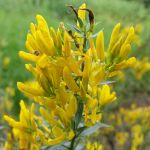| Common Name: |
Woad-waxen |
| Other Names: |
Dyer's Greenweed |
| Botanical Name: |
Genista tinctoria |
| Genus: |
Genista |
| Family: |
Papilionaceae |
| Native Location: |
Europe, W Asia |
| Cultivation: |
Light, well-drained soil in sun. Tolerates dry, poor, or sandy soils. Established plants do not transplant well. No regular pruning is required, but shoots can be thinned and/or pinched out after flowering to improve shape. Some Genista are subject to certain plant controls in parts of Australia. |
| Propagation: |
By seed sown in autumn or spring; by semi-ripe cuttings in summer. |
| Harvest: |
Leafy branches are cut before the plant sets seed, and dried for infusions. Dried herb should not be stored for more than a year. |
| Height: |
60-90cm (24-36in) |
| Width: |
1m (3ft) |
| Variations: |
Flore Pleno syn. Plena
Is dwarf, with double flowers.
Height: 35cm (14in)
Royal Gold is upright, with flowers in conical racemes, to 8cm (3in) long
Height: 1m (3ft) |
| Hardiness: |
Z4-7 |
| Parts Used: |
Flowering plant |
| Properties: |
A bitter, diuretic, purgative, emetic herb that acts as a weak cardiac stimulant and vasoconstrictor. |
| Medicinal Uses: |
Formerly used internally for gout, rheumatism, and dropsy; externally for fractures, sciatica, abscesses, and tumors. |
| Culinary Uses: |
Flower buds can be pickled as a substitute for capers. |
| Economic Uses: |
Flowers yield natural yellow dyes for wool. |
| Bibliography: |
Encyclopedia of Herbs by Deni Brown Copyright © 1995, 2001 Dorling Kindersley Limited. pg 222 |
